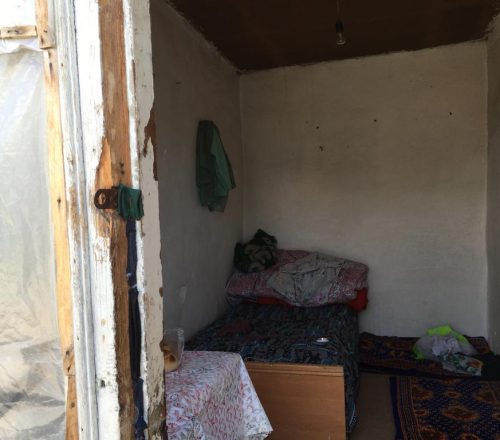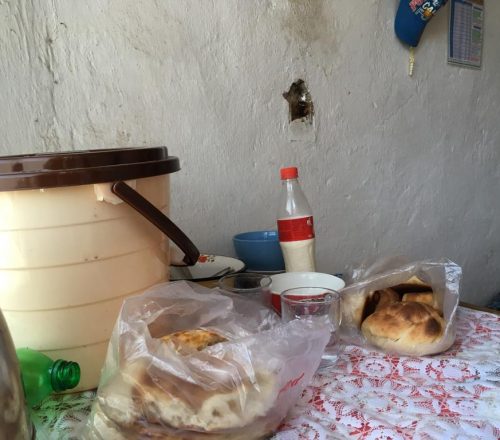Every third child in Kyrgyzstan lives in poverty and their number is rising every year.
Follow us on LinkedIn
This small room in one of the settlements of Bishkek is rented by a young family. It costs 1,000 soms per month (14.3 dollars). 38-year-old Aizhamal (not her real name) lives here with five children. For 1o years, she has suffered from beating and abuse by her husband. Finally, she got divorced from him, moved to the capital and took children with her. Until recently, she had worked as a seamstress and earned well. But after her mother’s death, Aizhamal’s immune system deteriorated significantly as a result of a stress and she got sick often. She had to drop her job temporarily and she has been sitting with her children at home for a few months already. The only source of income in this family is a child benefit “Ui Bulogo Komok.” The woman gets 4,000 soms (57.3 dollars) per month for five minor children. Her eldest daughter is 12 years old, but she has delayed growth, and her youngest son is 6 years old. Her four children attend school next to their house. “When I worked, it was not that difficult. I rented apartments for 5 thousand (71.6 dollars), I didn’t even consider the apartments like this one. But when I spent 3 months in a hospital, my relatives took my children and the landlord removed my stuff. All of them decayed in three months. And I was at the bottom. Now I am renting an apartment for one thousand soms. This is what my life is like now,” Aizhamal said. She is going to return to work next month. The woman cannot afford some rest and treatment any more.
Poverty threshold
According to the statistics, every third child in Kyrgyzstan lives in poverty. And every second family with four and more children is deemed a low-income one. As the number of people grows, the number of poor children grows as well.
A family in Kyrgyzstan is considered poor if it earns 2,674 soms (39 dollars) per capita per month. If it earns 1,456 (20 dollars) per capita per month, the family is deemed extremely poor.


State guarantor
Child poverty in Kyrgyzstan has been officially measured since 2010. The local methodology has been developed and adapted by UNICEF jointly with the state authorities. Since then, the National Statistical Committee calculates this rate on an annual basis.
“It’s important to know the child poverty rate. If we don’t know about it, or don’t have a measuring system in place, the problem won’t exist. It means we’ll have neither public disclosure, nor solution to it,” Gulsana Turusbekova, a social policy specialist of UNICEF, said. The report of the National Statistical Committee for 2013-2017 reads as follows:Integrated measures
According to the law “On welfare payments in the Kyrgyz Republic”, low-income families are paid 810 soms (11.6 dollars) every month per every child under 16 years of age. This is the only target measure of the national policy in Kyrgyzstan.
The National Statistical Committee calculates the living wage of able-bodied population, pensioners and children on a quarterly basis. It varies from 3.5 to 4.5 thousand soms (50-64.4 dollars) per child, depending on the age, as of the first quarter of this year. It means that the child benefit is 4-5 times below the living wage. However, not all low-income families can get this money. According to the recent researches carried out by international organisations, 63 per cent of those who need benefits do not receive them actually. And only 15 per cent of those who receive benefits do have a right to the same. Social welfare officers treat people roughly, which affects the number of appeals. Families must prove their aggregate household income does not exceed 900 soms to get the child benefit. Otherwise, they will not receive this money. However, the families find hard to prove it as they are employed unofficially. As a result, an element of corruption is involved in the process of child benefit allocation. According to the experts, targeting of government support has failed and the poorest group of people has been left uncovered by the system. A large and uncoordinated list of documents is called as one of the reasons. “It’s necessary to get and provide about 25 certificates to get a child benefit. Some of them contradict each other. For example, a low-income person may get a child benefit regardless of the place of registration. However, a certificate of the place of registration is required to get an unemployment certificate,” a member of Zhogorku Kenesh, Aida Kasymalieva, said to CABAR.asia. According to her, in 2018, the country saved 1.7 billion soms (24.34 million dollars) on welfare payments, i.e. the money that low-income families could not receive due to the problems with documents. A task force has been created in the parliament to monitor the law on welfare payments and to register all shortcomings. According to Kasymalieva, they are eliminating contradictions and reducing the list of required documents. However, she noted that a large group of low-income citizens is left uncovered by the welfare system due to the lack of documents. “For example, people living in the settlements of Bishkek have no documents. They cannot get certificates because they live in unlawful settlements. Moreover, many of them cannot even present a passport,” Kasymalieva said. She noted that it is critically important for a child under three years of age to get good nutrition in order to develop properly. “It’s necessary to cover all children below three years of age, to eliminate the richest, children of those who hold high political posts and those who work with international organisations. Then the coverage would be wider. The child benefit would cover children of doctors, teachers, reach the wider population and would be invested into the development of children, thus eliminating the poverty,” the legislator said. An expert in social security and child poverty, Zhypara Rysbekova, said the situation could not be improved by benefits only. According to her, a set of measures is needed, which the government has not taken yet: “Today the measures the government is taking to decrease the level of poverty among children are not enough. In addition to passive policy in the form of benefits, more active policy should be pursued, which means provision of services, case management in terms of social protection. A set of measures should be involved.” The main image is illustrative. Source: knews.kgThis article was prepared as part of the Giving Voice, Driving Change – from the Borderland to the Steppes Project implemented with the financial support of the Foreign Ministry of Norway. The opinions expressed in the article do not reflect the position of the editorial or donor.



